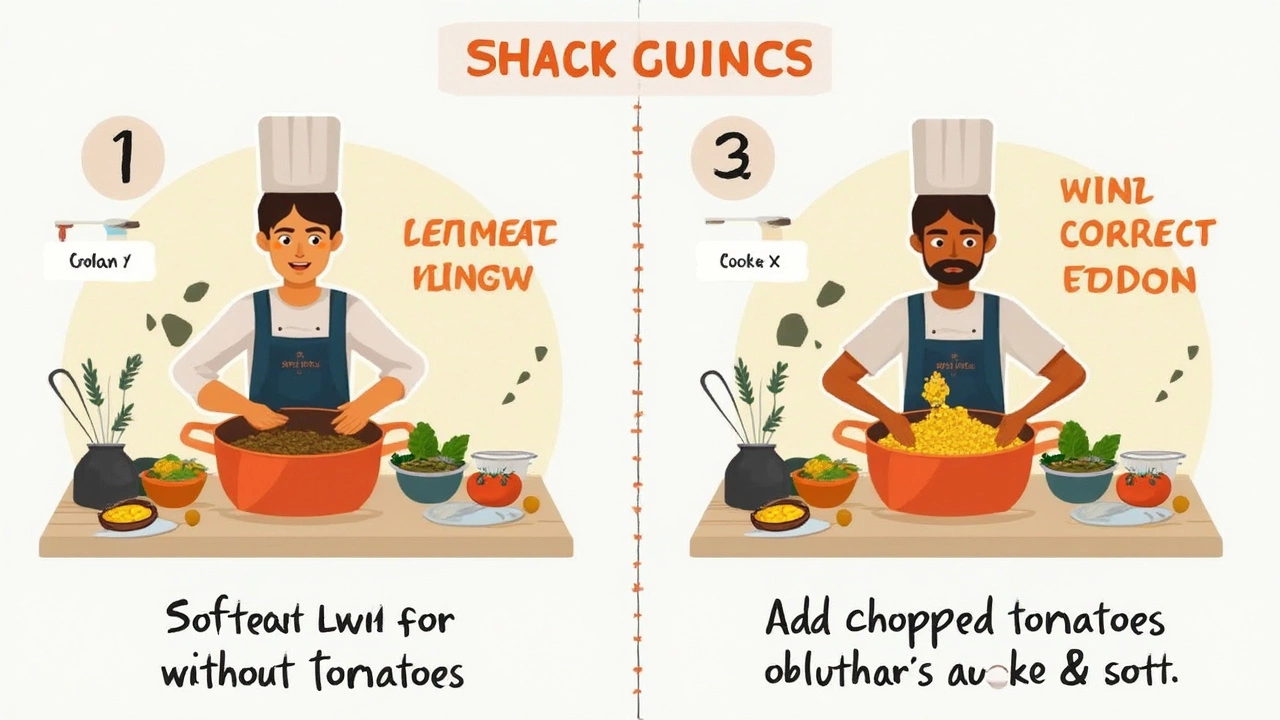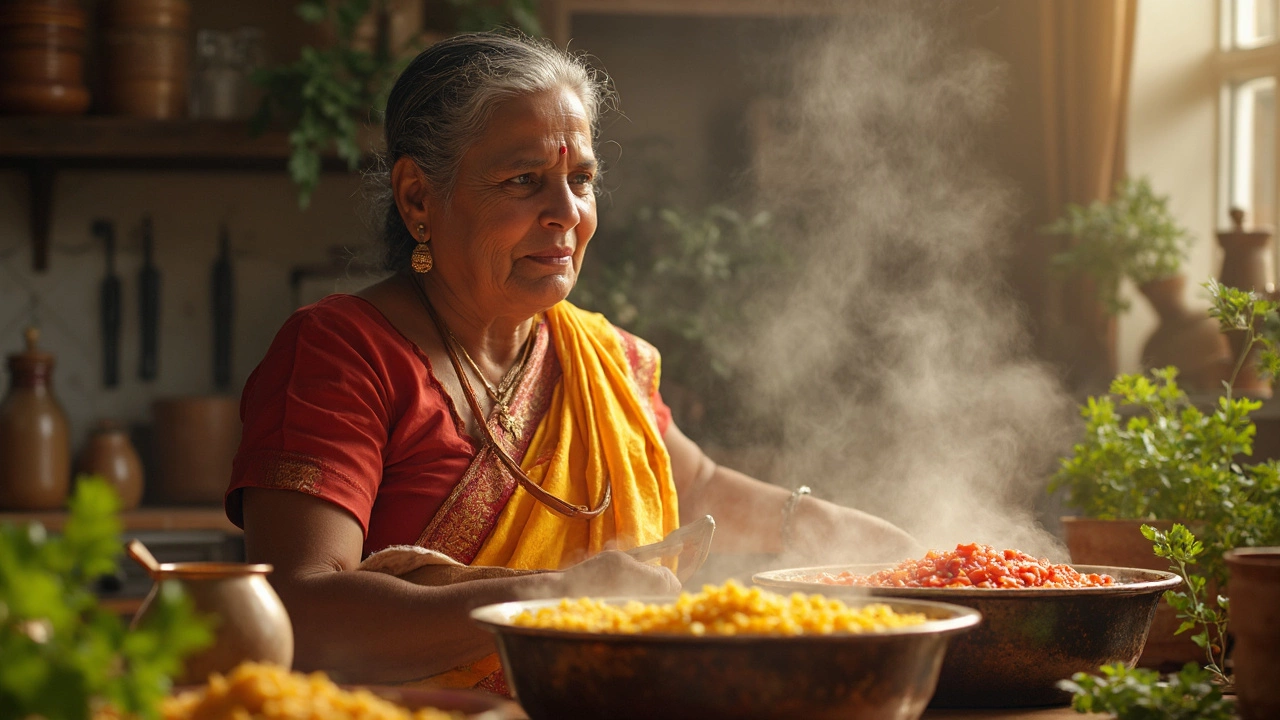Ever sat staring at your pot of dal, wondering why the lentils stay stubbornly hard, no matter how long you cook them? If you tossed in tomatoes from the start, that's likely your culprit. Tomatoes are acidic, and acid can put the brakes on lentils turning soft. It's not just tomatoes—lemon juice or tamarind does the same thing. This isn't some kitchen myth; it's chemistry at work.
So, how do you get perfectly soft dal without sacrificing tomato flavor? Most home cooks have been there, waiting (and waiting) for the dal to break apart, but the truth is, timing matters. Your tomatoes should go in after the lentils are cooked through. That way, you get all the tang without the chewing marathon.
Keep reading to unravel the real science behind it, how to fix an undercooked batch, and kitchen tricks to never face this problem again. Cooking dal should be simple and satisfying—not a mysterious struggle.
- The Real Science: Why Lentils Stay Hard with Tomatoes
- Timing the Tomatoes: When to Add for Best Dal
- Fixes and Hacks: Rescue Your Dal If It Won't Soften
- Everyday Tips for Foolproof, Soft Lentils
The Real Science: Why Lentils Stay Hard with Tomatoes
Here’s what’s really happening in your pot. Lentils, like most beans and legumes, get soft when their cell walls break down during cooking. The magic is in the pectin, a natural fiber that holds those cell walls together. When you add acid — like from tomatoes and dal — it actually reinforces the pectin, making it harder for the water and heat to do their thing. That’s why your dal recipe simple can go sideways if you throw in tomatoes too early.
This is backed by food science, not just tradition. Most home cooks in India know this from experience, but there are real studies showing acids slow down the softening of legumes. Even just a splash of lemon juice or a few chopped tomatoes in the beginning can increase the cooking time drastically — sometimes by an extra 30–40 minutes. If you’re using older lentils or hard tap water (which has lots of calcium and magnesium), the struggle is even more real.
Check this out for a quick comparison:
| Lentils Cooked Without Acid | Lentils Cooked With Tomatoes | |
|---|---|---|
| Time to Soften (on stovetop) | 25-30 min | 50-70 min |
| Texture | Soft, breaks easily | May stay firm, uneven texture |
So next time you wonder why your lentil cooking tips online keep stressing sequence, you know it’s not just for flavor. It’s pure science, and it can make or break your dal recipe simple. Keep tomatoes out until your lentils have softened up nicely and you’ll never have to deal with crunchy dal again.
Timing the Tomatoes: When to Add for Best Dal
If you want soft, melt-in-the-mouth lentils in your dal recipe simple, it's not just what you add, but when you add it. Tomatoes bring in that tangy flavor and beautiful color, but they can seriously slow down how fast lentils cook. Acidity is the issue—when tomatoes go in early, their acid locks up the lentils' skins and keeps the insides firm. This means you could stand over the stove forever and still get chewy dal.
The fix is easy. Don’t drop tomatoes at the start. Instead, cook your lentils with just water, salt, turmeric, and maybe a bit of oil or ghee. Once they’re soft (usually after 20–30 minutes, depending on the type), then stir in your chopped or blended tomatoes. Let this mix simmer together so those tomato flavors infuse, but your dal stays blissfully soft.
Here’s a quick checklist for tomatoes and dal timing:
- Boil lentils till almost mushy—only water and basic spices
- Sauté tomatoes in a separate pan if you want extra depth, then add to dal
- Let everything simmer together for 5-10 minutes after tomatoes go in
- Add lemon juice or more acid only at the end, if you use it
Pressure cookers? Same rules. Pressure-cook the lentils first, then do the tomato tadka (tempering) and mix it in. Every seasoned home cook in India swears by this—ask anybody’s mom or grandmother and they’ll tell you the same story.
Here’s a quick breakdown:
| Step | When to Add Tomatoes |
|---|---|
| Start Boiling Lentils | No |
| When Lentils are Soft | Yes |
| With Tempering (Tadka) | Yes |
So if you want your next dal recipe simple to actually give you creamy, perfect lentils, wait until those lentils break down before making them meet the tomatoes. You’ll taste—and feel—the difference.

Fixes and Hacks: Rescue Your Dal If It Won't Soften
So you added tomatoes too early and now your dal is still hard. No shame—we’ve all done it. Before you chuck the whole pot, here are some tried-and-true fixes to rescue your batch. If your lentils haven’t fully softened because of the acidity from tomatoes, don’t panic.
- Pressure cook it again: This might sound obvious, but running your dal through another couple of whistles in the pressure cooker usually does the trick. Add a little extra water to keep the dal from burning at the bottom. It even works if you already added tomatoes, though it may take longer than usual.
- Add hot water, never cold: If your lentils are still stubborn, pour in boiling water instead of cold. Cold water actually tightens up the outer skin of lentils even more, making them harder to cook.
- Baking soda magic: Sprinkle a pinch (really, just a tiny pinch) of baking soda into your dal. This neutralizes the acid from tomatoes and helps break down the lentils. Don’t go overboard—too much can ruin the taste.
- Separate cooking: Next time, cook the lentils alone (with just water, salt, and turmeric). Once they’re almost mushy, only then add tomatoes or tamarind for that tangy kick. This trick can save you the hassle every time.
For quick reference, here’s a side-by-side comparison showing why some fixes work:
| Hack | Why it works |
|---|---|
| Pressure cooking again | Extra heat helps break down lentils despite the acid |
| Hot water | Doesn’t toughen skin, keeps heat up for even cooking |
| Baking soda | Neutralizes acidity, softens lentils faster |
| Separate cooking | Keeps acid away until lentils are fully cooked |
One last thing—if you live somewhere with hard water, that can make your dal tough even without tomatoes. Try filtered water or add a pinch of baking soda upfront. Remember, soft and creamy dal is just a little kitchen know-how away.
Everyday Tips for Foolproof, Soft Lentils
If you're tired of tough dal, let's break down exactly how you can get soft lentils every single time—no matter your skill level. Here’s a bunch of tried-and-true tricks I swear by in my own kitchen, all geared toward perfect dal recipe simple results.
- Soak your lentils first. Even just 20–30 minutes in warm water makes a huge difference. For thicker-skinned lentils like toor or chana, go for at least an hour. Soaking jumpstarts the softening process and slashes your cooking time in half.
- Bring up the heat. Lentils cook best at a gentle simmer, not a wild boil. Use a pressure cooker or Instant Pot if you’ve got one—just 3 whistles for most dal. Otherwise, keep the stove at medium for even cooking.
- Hold the acid. Don’t drop in tomatoes or lemon juice until the lentils are already soft. Acidic ingredients make lentil skins tougher, slowing down the whole process. Add all your tangy stuff at the end for best results.
- Salt timing matters. Salt can also slow down softening a bit if added too early. If you want the softest dal, toss salt in once your lentils have already started breaking down.
- Check your water hardness. Hard tap water has more minerals, and that can slow things down. If your dal refuses to soften, try filtered or bottled water instead.
- Older lentils = longer cook. Lentils that have been sitting in your pantry for months (or years) just take longer to soften. Use the freshest lentils you can find, especially for a dal recipe simple that’s quick and fuss-free.
Here’s a quick cheat sheet you can keep handy the next time you’re cooking dal:
| Lentil Type | Soak Time | Pressure Cooker | Open Pot |
|---|---|---|---|
| Moong Dal | No soak needed | 1-2 whistles | 20-30 min |
| Toor/Arhar Dal | 30 mins-1 hour | 3-4 whistles | 45-60 min |
| Masoor Dal | 20-30 mins | 1-2 whistles | 20-30 min |
| Chana Dal | 1-2 hours | 4-5 whistles | 60-90 min |
Certain brands of tomatoes and dal behave differently, too. Some tomatoes are more acidic than others—Roma tomatoes, for example, tend to be a bit more tangy. If you love a lot of tomato flavor, blend and cook them separately, then stir into the finished dal for all the taste and none of the hard-lentil drama.
Bottom line: soft, tasty dal is all about soaking, timing your acids, and watching the water. Follow these tips, and you’ll never have to dread chewy, half-cooked lentils again.
